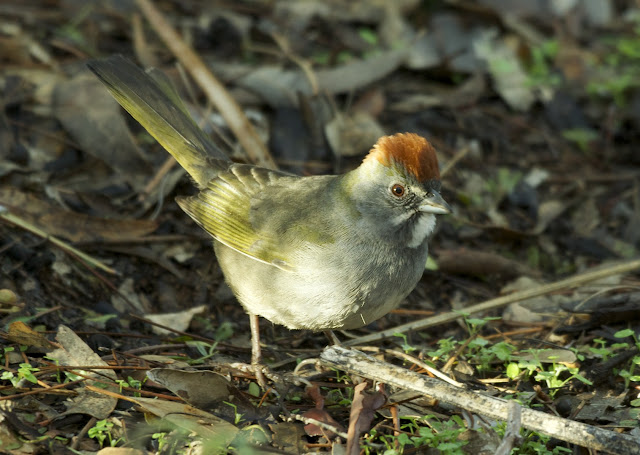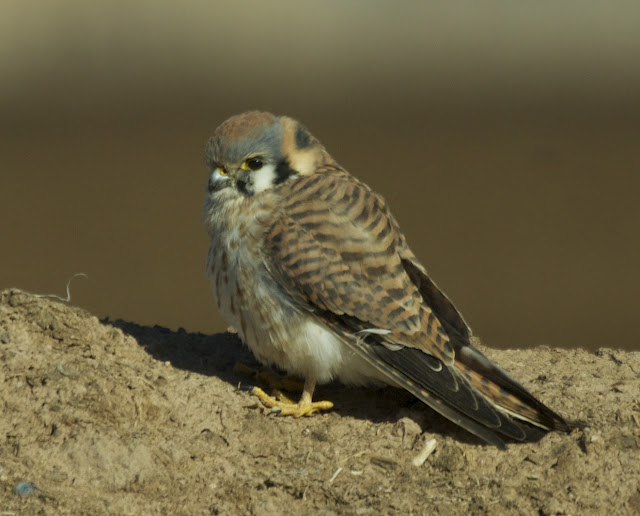For whom did the Bell's toll? Not too long ago, it tolled for the Sage Sparrow. That once noble and singular species was callously and scientifically split into two equally noble species with slight differentiation and range overlaps. Such splits are usually welcomed by birders, as it means another potential tick for the ol' Life List, and maybe even a 'buy one, get one free' if both species were seen before being divided. Arizonans came off particularly well with the split too, because both species can be found co-habitating in the central area of the state (and elsewhere), though it takes some serious scrutiny to tell them apart.

The Thrasher spot in Buckeye, some thirty miles west of Phoenix, is already a famous and well-visited site. It's perhaps the best site in Arizona to turn up Le Conte's Thrashers, and often provides Crissal as well as Bendire's and Sage in the right months. Since it also plays host to both species of the former conglomerate Sage Sparrow, it's equity has only increased with recent appraisals. Never mind that it's next to a nuclear plant!!!
Last week I undertook a mission to find and photograph both of the new species, plus anything else that was up and about in the cold scrub. I succeeded in half of the endeavor--finding both species--but failed in photographing the Bell's Sparrow, which is also the less common of the two in central AZ. With this spot already being so high on many
birdingpal's lists, I'm sure I'll get another chance.

The Sagebrush Sparrow tends to have a more distinctly gray head and heavier streaking on the back and mantle. The particular specimen shown both above and below had darker streaking, though it stopped a little shorter than expected, but the gray of the head shown pretty distinctly against the browner back, and as such I'll call this a Sagebrush.
The malar stripe is one of the better distinguishing features. Sagebrush Sparrows feature a malar stripe that is the same color as (thus, not in contrast with) the head and it tends to be of a thinner width. Honestly, this particular specimen troubled me a bit because the malar strip seemed thicker than I expected, having looked and many pictures of Sagebrush vs. Bell's comparisons on the interwebs. The lack of contrast still points to Sagebrush for me. That being said, it's maybe a tiny bit darker, and could this even be a younger, less apparent bird??? I dunno, I hate this hobby...

Before heading out west I met up with New Mexico birdingpal Mark, who was in town for several days and wanted to have some photo opportunities with the Arizona annuals. After we scoured the scrub for a bit, also getting quick looks and Bendire's and Crissal Thrasher, we took the scenic drive down Salome Hwy to Arlington, stopping for many the raptor along the way, including a handsome Ferruginous Hawk named Rusty Venture.
In the (sadly) few photo-ops I've had with this species, both of mature adults and immature birds (which can be told apart by their juvenile sense of humor and pimply faces), I have noticed a consistent, serial-killer stare when in direct eye-contact. Look at that gleam...he's got murder on the mind.

The Thrasher Spot and Arlington drive offers some great looks at some particular, esoteric species, but doesn't offer a surfeit of species overall. Thus, any trip to the west side of Maricopa is best capped off with an hour at Tres Rios to bump the day list into the seventy or eighty species tally where it belongs. I don't exactly hang my head in shame when I say this is perhaps the best photo of a Belted Kingfisher that I've managed--they're a skittish bird--but I kinda do.

For the first time ever,
Burrower's Row just north of Tres Rios was deserted. We did drive by a fellow who was rather brazenly discharging his shotgun at blackbirds on the telephone wires nearby, so this was perhaps keeping the wise Owls underground. The detour wasn't entirely for naught though, as this American Kestrel stayed perched alongside the road long enough for some nice shots. Apart from Red-tailed Hawks, this is the most common raptor in Arizona, but it's pretty rare for me to see them at eye level--a nicer sighting, in fact, than the Burrowing Owls on which I am already spoiled.
An American Pipit was also pipiting along the berm. They're kinda dull birds but they make me happy.
The cattle farm on Broadway was not quite as productive as on my last visit, when I delightedly watched a family of Black-bellied Whistling Ducks frolic in the bovine excrement ponds, but any beer enthusiast appreciates this blackbird.
And Yellow-headed Blackbirds are just objectively pretty no matter what sort of enthusiast you are.
I'll try again for the Bell's Sparrow in a few weeks. On a related note...if you have any thoughts on the above Sparrow contrary to it being Sagebrush, let me know. Hope to see y'all in the field some time.























































